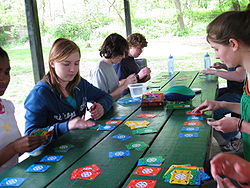Dutch Blitz

Homeschooled youths playing Dutch Blitz
|
| Players |
2-4 |
| Age range |
8 and up |
| Playing time |
Approximately 5-10 minutes per round |
| Random chance |
Medium |
| Skill(s) required |
Hand-eye coordination, speed, counting |
Dutch Blitz is a fast-paced, family oriented, action card game played with a specially printed deck. The game was created by Werner Ernst George Muller, a German immigrant from Bucks County, Pennsylvania. The game is very popular among the Pennsylvania Amish and Dutch community, and among Christian groups in the United States and Canada (primarily in Dutch and German communities). The game is similar to Nertz, but Nertz is played with four standard playing decks, while Dutch Blitz must be played with specialized decks.
It is an alternate version of the game Ligretto, manufactured in Germany.
Contents
- 160 cards total:
- 4 decks; Pump, Buggy, Plow, and Bucket.
- Each deck includes 10 red, 10 blue, 10 green, and 10 yellow cards.
Terminology
- This pile of 10 cards is the most important pile of cards to each player since it is the key towards "Blitzing" the other players when all cards from this pile have been cleared.
- Stacks of cards in each of the four colors - 1 through 10 an ascending sequence - placed in the center of the table and played upon by all players. Each player accumulates scoring points here.
- Groups of cards placed to the left of both the Blitz and Wood piles in descending sequence For each player, the Post Piles serve as a "trading" or replacement area during the game. There are generally three post piles but in a two person game four or five post piles are often used to prevent the game from stalling.
- Stack of cards built to the right of a player, from cards held in that player's hand.
Objective
The objective of Dutch Blitz is to score points by playing as many cards as possible on Dutch Piles, and by emptying the Blitz Pile as quickly as possible. This is done by playing cards from the Blitz Pile, Post Piles, and Wood Pile on the Dutch piles.
Point scoring
The game ends when a player plays all 10 of the cards out of his/her Blitz Pile and yells "BLITZ!". Each player scores points at the end of each hand as follows:
- Add one point for each card that had been thrown out in the Dutch Piles.
- Subtract two points for each card the player has left in his/her Blitz Pile.
Usually more rounds are played until one player reaches 100 cumulative points, yet some games have gone on for days at a time.
Variations
A variation of the game relies on larger sized cards and can be called "Full Contact Dutch Blitz", "Running Dutch Blitz" or "Life Size Dutch Blitz". The larger cards must be physically run to the their respective piles. This can also be a team game and is a popular activity at church retreats.
COMMENTS








